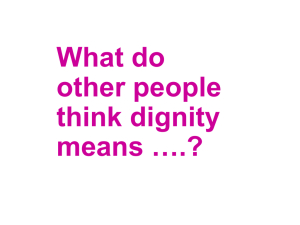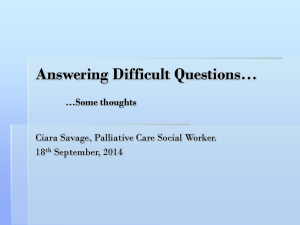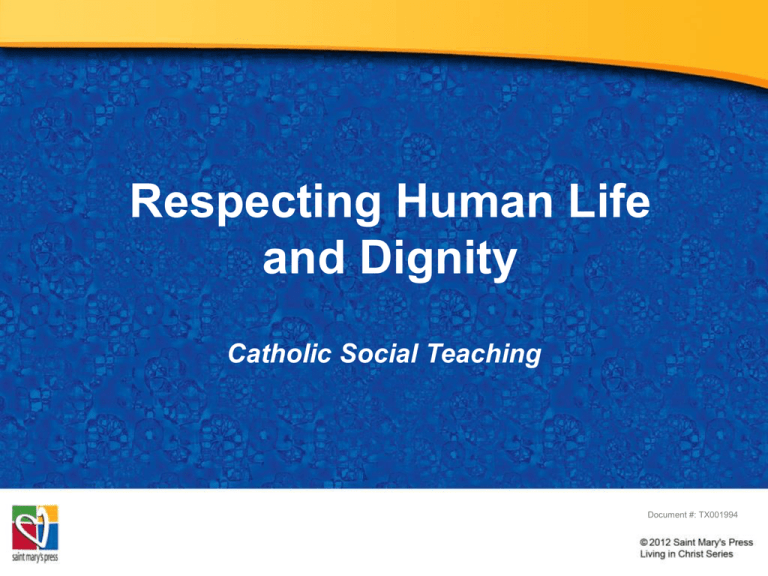
Respecting Human Life
and Dignity
Catholic Social Teaching
Document #: TX001994
A Culture of Life versus a
Culture of Death
Pope John Paul II wrote about the
moral shifts occurring in society,
specifically abortion and
euthanasia.
By Clarence Goss from USA (Flickr:Got You Daddy) [CC-BY-2.0
(www.creativecommons.org/licenses/by/2.0)], via Wikimedia Commons
Abortion and euthanasia are two
serious sins against the sanctity
of life and are violations of the
Fifth Commandment.
The Culture of Death
In The Gospel of Life, John
Paul II identifies two
contemporary causes of the
culture of death:
• adopting a distorted understanding of human freedom
• making something other than God the center of our lives
By Shayan Sanyal (Flickr) [CC-BY-2.0 (www.creativecommons.org/licenses/by/2.0)], via Wikimedia Commons
The Culture of Death
(continued)
First, people today often adopt a
distorted understanding of
human freedom.
• Some people think that we should
have the right to pursue our personal
goals and desires without any
hindrance.
• The Church teaches that human
freedom is a gift and not an absolute
right.
The Culture of Death
(continued)
Second, when God is not the center of
our lives, we can become preoccupied
with material things at the expense of
others, which leads to suffering.
The gift of freedom comes with responsibility:
• to choose right over wrong
• to choose love over hate
• to choose solidarity over self-centeredness
• to choose life over death
Image in shutterstock
Promoting the
Culture of Life
• As members of God’s family, we
must serve others through works
of charity.
• Civil leaders have particular
responsibility to make courageous
choices in support of life.
• Families also play a special role in
building a culture of life.
Partner Discussion
Turn to a partner and share:
• In what ways can civil leaders promote a culture of life?
• In what ways can families build a culture of life?
Conscience and the
Culture of Death
In its January 2, 1973, Roe v. Wade
decision, the U.S. Supreme Court ruled
that states cannot limit a woman’s right
to an abortion during the first trimester of
her pregnancy.
By Clarence Goss from USA (Flickr:Got You Daddy) [CC-BY-2.0
(www.creativecommons.org/licenses/by/2.0)], via Wikimedia Commons
After abortion was legalized, it became
more common to believe that unborn
children do not have full human rights.
This human rights issue can lead to
questions about the dignity of others,
especially those who are elderly or
infirm.
End-of-Life Issues: Euthanasia
Euthanasia, also known as mercy killing, is
a serious offense against the Fifth
Commandment. Proponents of euthanasia
make it an issue of human freedom.
God’s Law makes it clear that intentionally causing the death of a human being is
murder, regardless of the motive or circumstances.
According to the teachings of the Catholic Church, euthanasia violates human
dignity and the respect we owe to our Creator, the author of human life.
Large-Group Discussion
• In what ways is the Catholic Church’s view on euthanasia different from
society’s view on euthanasia?
• What foundational principles govern the Church’s view?
End-of-Life Issues: Suicide
• Suicide is a grave offense against
the Fifth Commandment.
• Suicide is the ultimate rejection
of God’s gifts of hope and love.
• Although suicide is always
wrong, the Church recognizes
that serious mental illness or
suffering can contribute to the
decision to take one’s own life.
Image in shutterstock
End-of-Life Issues: Suicide (continued)
If you know someone who is thinking about suicide, it is essential that you tell
someone who can get the person the medical, psychological, or spiritual help
she or he needs, even if it breaks a promise of confidentiality.
If you know someone who has committed suicide, do not consider her or him
forever lost to the love of God or condemned to Hell. As the Church, we pray for
those who have committed suicide, placing them in God’s love and mercy.
Large-Group Discussion
What are some action steps you could take to help yourself or a friend who is
considering suicide?
End-of-Life Issues:
The Death Penalty
Taking the life of another is an
offense against the Fifth
Commandment.
Pope John Paul II teaches in
The Gospel of Life that the
death penalty should be “very
rare, if not practically nonexistent.”
End-of-Life Issues: The Death Penalty (continued)
The Catholic Church is generally against the death penalty for the
following reasons:
• The New Law taught by Jesus emphasized mercy and forgiveness.
• Advancements in the criminal justice system allow for imprisonment for a
lifetime as well as the capacity to ensure that prisoners in maximum-security
prisons have minimal risk for escape.
• Conversion of heart and lifestyle through rehabilitation is always possible.
Protecting Dignity:
Sexual Exploitation
Men and women are called to acknowledge the dignity of their own sexual identity.
Two Commandments remind us that sexual sin has social consequences:
• the Sixth Commandment: “You shall not commit adultery.”
• the Ninth Commandment: “You shall not covet your neighbor’s wife.”
Protecting Dignity: Sexual Exploitation (continued)
The virtue of chastity helps us to live out our sexuality with integrity. We are
called to respect ourselves and others because we are created in the image
and likeness of God.
Quick Write
• How does the message of media and society regarding chastity affect your
view on chastity? Provide concrete examples.
• Who influences your personal thinking regarding chastity? God? society
and media? Explain your answer.
Societal Exploitation
of Sexuality
The media often exploit the human dignity of sexuality. For example, the
pornography industry creates and distributes sexually explicit stories, images,
and video.
Pornography is a serious social sin because it objectifies men and women and
disrespects the gift of sexuality. This can lead to the sins of premarital sex and
adultery.
Sexism
Sexism takes many forms, including . . .
• not allowing one gender equal rights in society
• overlooking verbal, sexual, and physical abuse against one gender
• not allowing one gender equal work opportunities or equal pay for equal work
Racism
WikiMiediaCommons
Racism is a sin committed by individuals and also by social structures that
perpetuate racist policies and practices.
Once the relationship between two races is marked by humiliation,
abuse, or physical violence, the prejudice and distrust can last for years.
This is another consequence of Original Sin.
The Church and Racism
The U.S. Catholic bishops speak out
against racism in their pastoral letter
Brothers and Sisters to Us. They teach
that racism is a sin that
• divides the human family
• violates the fundamental human
dignity of those called to be
children of the same Father
Image in shutterstock
Stereotyping
The way we treat others is based
on the way we view them.
Sometimes our assumptions about
a person are based on stereotypes.
The problem with stereotypes is that
they are often inaccurate or untrue,
and they do not respect each
individual’s uniqueness.
Image in shutterstock
Prejudice
Prejudice is often displayed as
ignorance, fear, or hostility directed
toward a specific race or ethnicity,
gender, economic class, or ability.
• Prejudice is based on a
preconceived judgment without
knowing all the facts.
• Negative prejudicial attitudes
harm human dignity.
Image in shutterstock
Discrimination
Prejudice becomes discrimination
when people in power are
motivated by prejudice to deny
members of a particular group
their rights.
• Discrimination can apply to
issues of race or ethnicity,
gender, class, or ability.
• Overcoming the many faces
of discrimination takes a longterm commitment to work for
justice.
Image in shutterstock
People with Disabilities
People with physical, mental,
emotional, or developmental
disabilities are also the victims of
prejudice and discrimination.
We should remember that Jesus
showed great concern for people with
disabilities
As the Body of Christ, the Church
is committed to ending
discrimination against people with
disabilities, both within the Church
and in society.
Migration and
Immigration
Immigration is a very sensitive issue
in our time, both politically and
emotionally.
The Church calls for the elimination of
the root causes of such migration:
poverty, injustice, lack of religious
freedom, and war.
Social Justice Principles on Migration and Immigration
The United States bishops teach the following principles related to
migration and immigration.
1. People have the right to find opportunities in their homeland.
2. People have the right to migrate to support themselves and their families.
3. Sovereign nations have the right to control their borders.
4. Refugees and asylum seekers should be afforded protection.
5. The human dignity and human rights of undocumented migrants and
immigrants should be respected.
Respecting all human life
and dignity is our
responsibility and our duty
as disciples of Christ.
Quick Write
What can you do to help to
promote immigration reform in
accordance with the U.S.
bishops?
Image in shutterstock

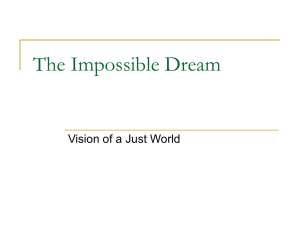
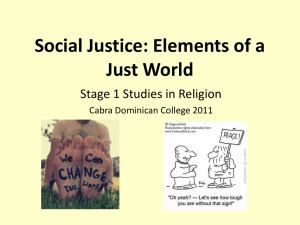
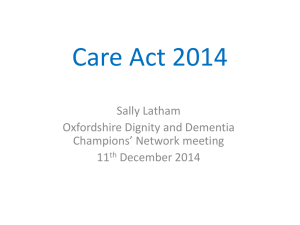
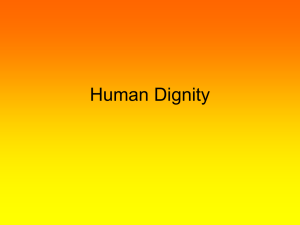
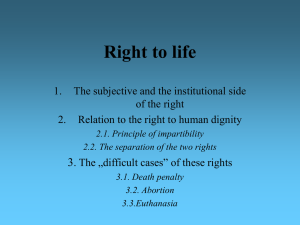


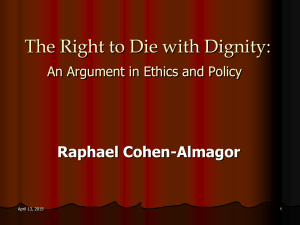
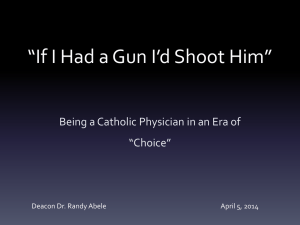
![4[1]._a_man_as_a_person](http://s2.studylib.net/store/data/005226893_1-b67b2be2c3623c1c44b6baa80b997c62-300x300.png)
